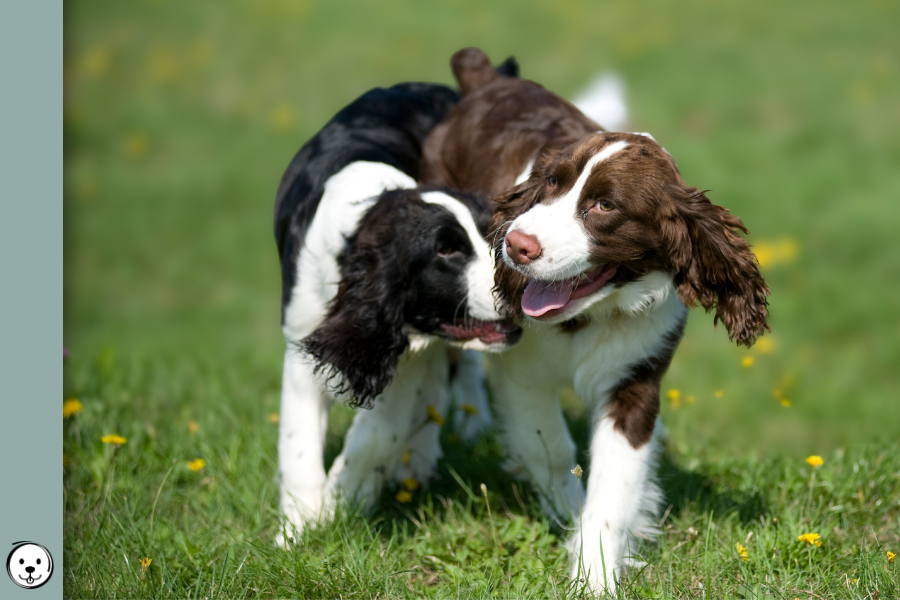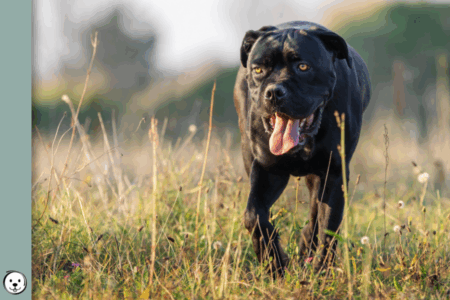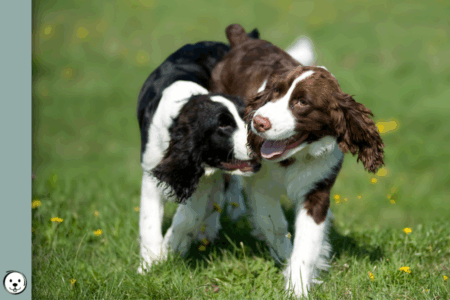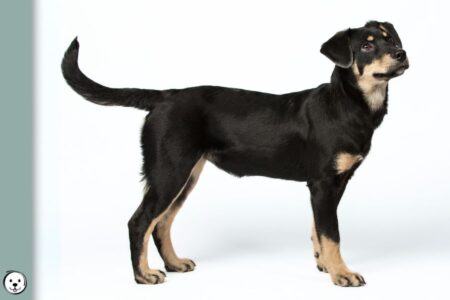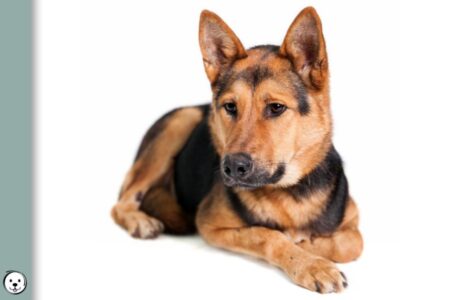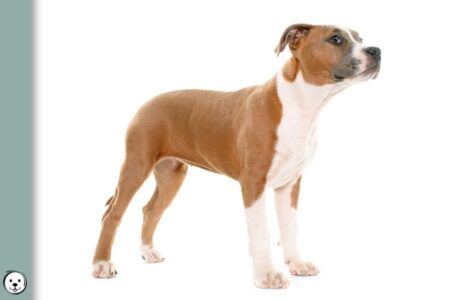Learn all about the different English Springer Spaniel coat colors.
Table of Contents
English Springer Spaniel Breed Standard
The colors listed by the AKC, FCI, and KC breed standards:
“All the following combinations of colors and markings are equally acceptable: (1) Black or liver with white markings or predominantly white with black or liver markings; (2) Blue or liver roan; (3) Tricolor: black and white or liver and white with tan markings, usually found on eyebrows, cheeks, inside of ears and under the tail. Any white portion of the coat may be flecked with ticking.“
AKC Breed Standard[1]
“Liver and white, black and white, or either of these colours with tan markings.“
FCI Breed Standard[2]
“Liver and white, black and white, or either of these colours with tan markings. Any other colour or combination of colours unacceptable.”
KC Breed Standard[3]
English Springer Spaniel Color Chart
Check out this English Springer Spaniel color chart:
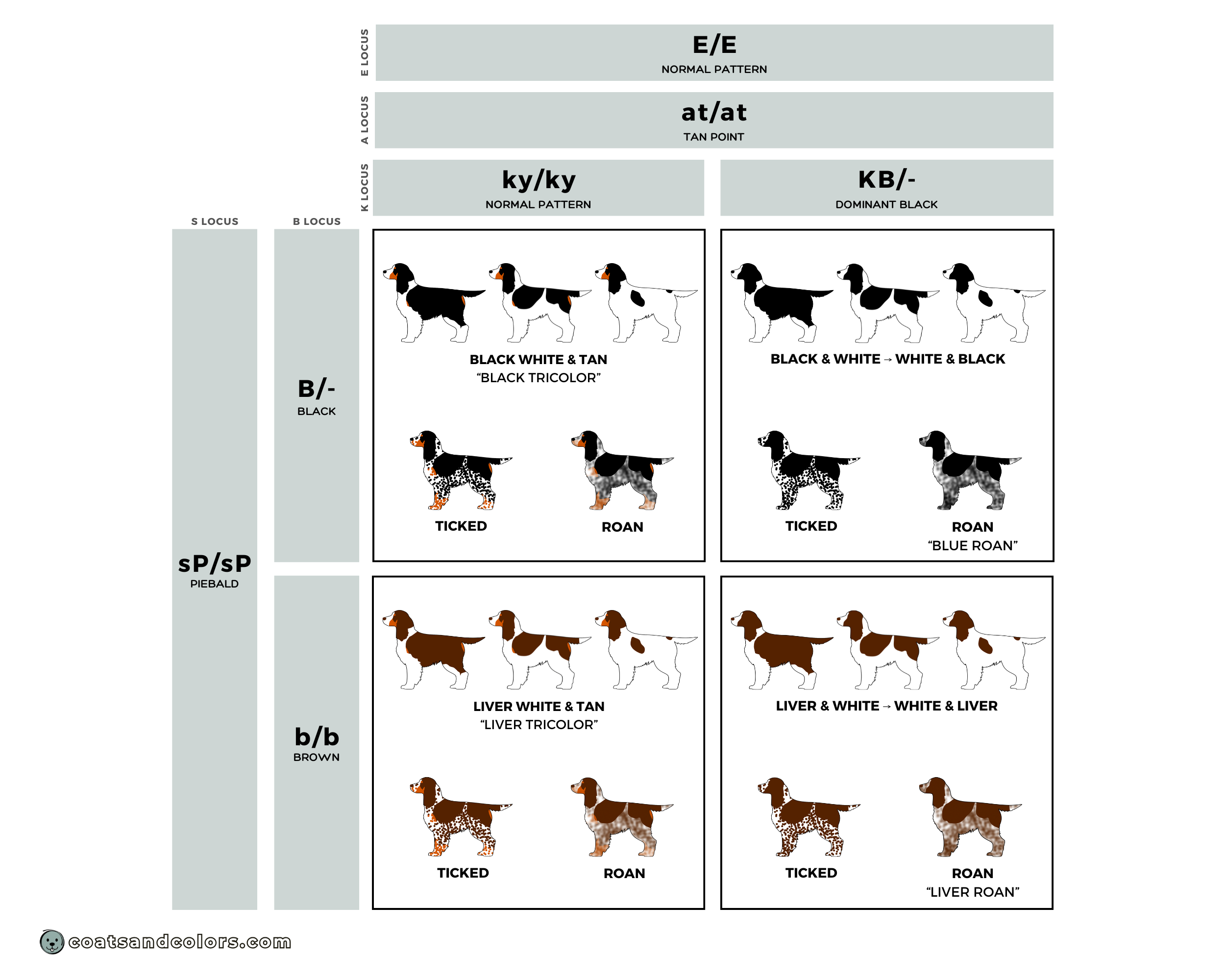
English Springer Spaniel Coat Type
The coat type can significantly affect how we perceive coat colors.
The English Springer Spaniel is a long-haired (l/l) dog breed with a “flat or wavy coat“. Some Springers have one or two curly alleles which means that any longer coat may be wavy (Cu/N) or curly (Cu/Cu). They have smooth coat on their face and legs since they obviously don’t have furnishings (N/N).
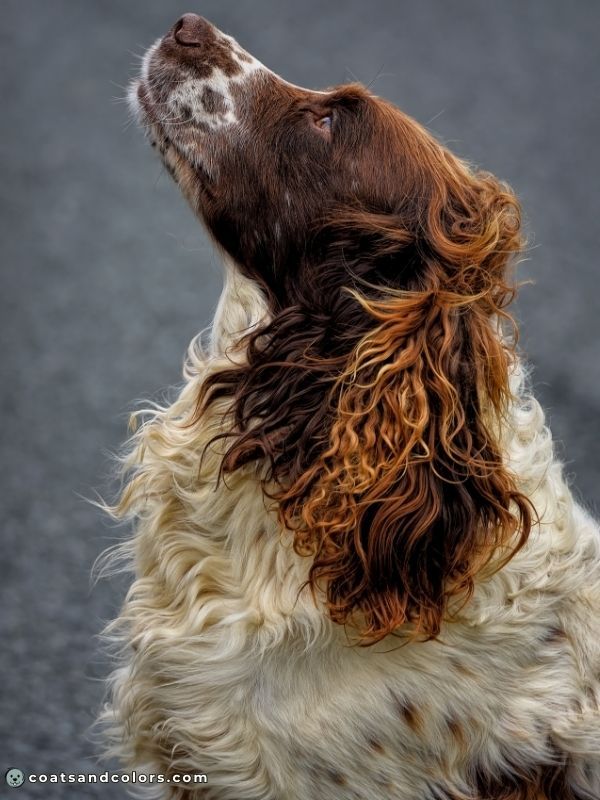
English Springer Spaniel Standard Colors
English Springers only have two accepted patterns: solid dark or tan point. Both patterns can come with black or liver pigment. And both patterns always have white markings which may show ticking or roan.
Some more details on standard colors in this breed:
Black & White English Springer Spaniel
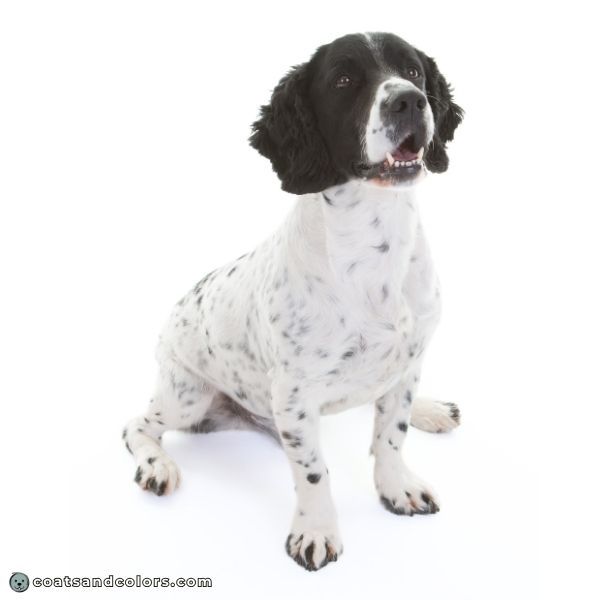
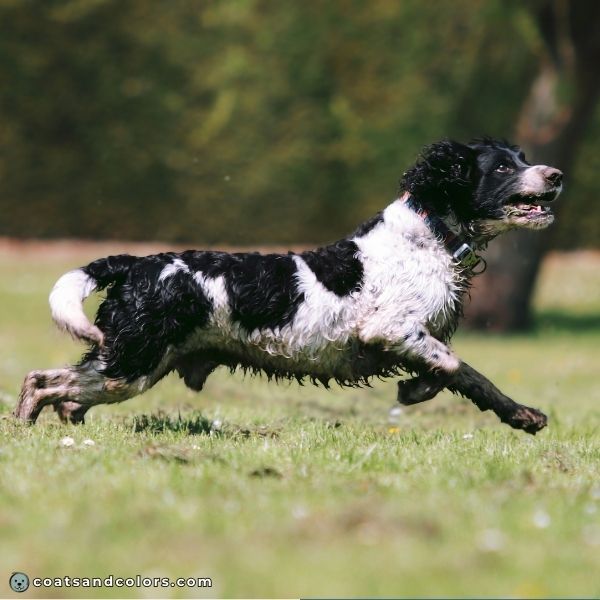
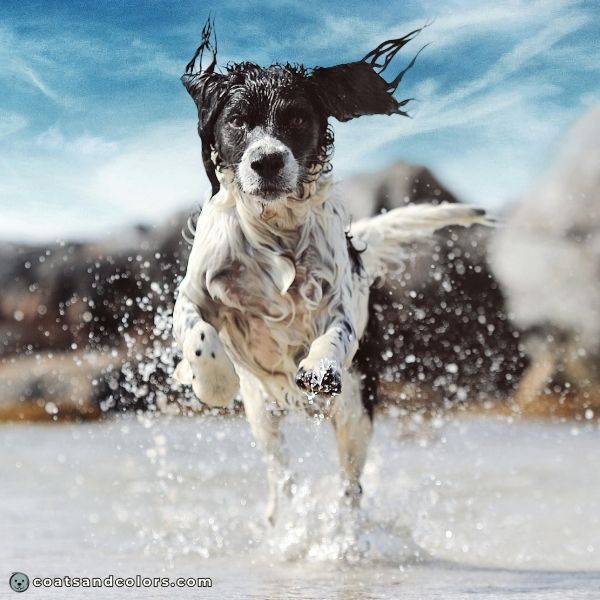
Eumelanin:
black-based pattern (B/- D/D)
Phaeomelanin:
none
Base Pattern:
dominant black (KB/-)
recessive black (a/a ky/ky)
White:
piebald (sP/sP)
ticking/roan possible
Most black & white English Springers express a dominant black pattern (KB/-). This means the tan point pattern (at/at) at their A locus will be hidden by a solid dark coat. They can be E/- (wild type) or Em/- (dark mask) at the E locus, you just can’t see if they have a black mask when they are already solid black.
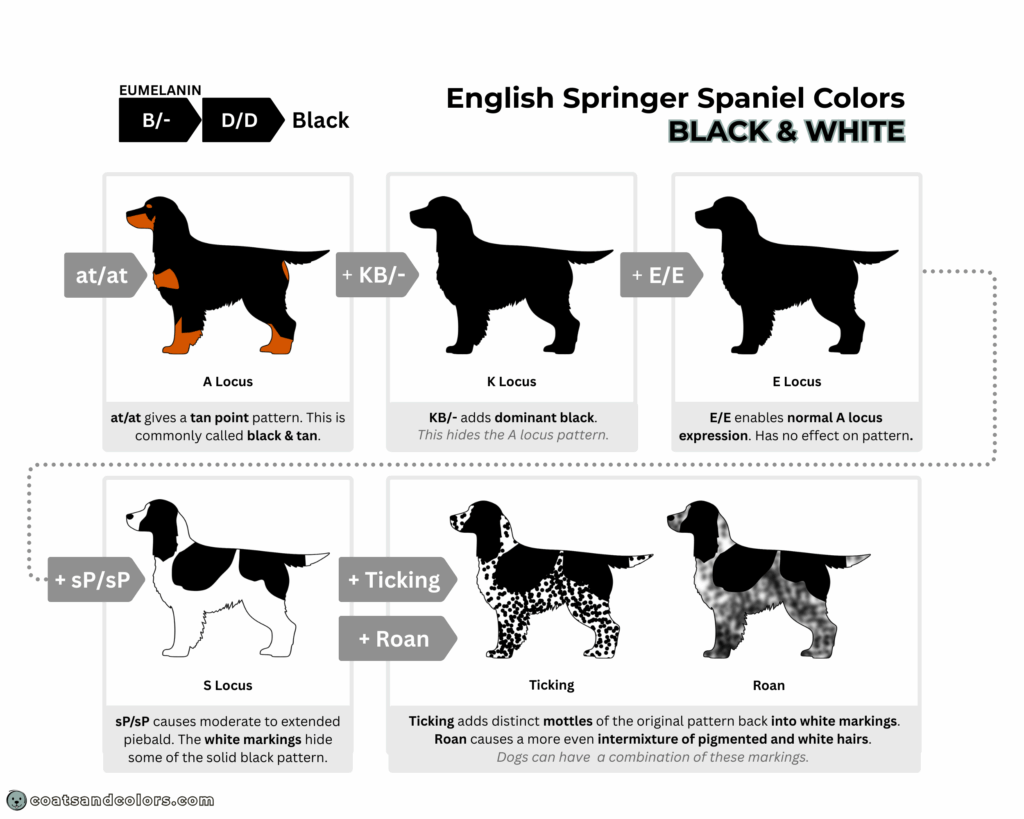
Some KB/- dogs might have ghost tan. This is less common in some breeds than others. An unknown modifier makes their dominant black incomplete, allowing the underlying tan points to show through. Ghost tan is often only visible in direct sunlight and can result in subtle reddish face markings.
Most Springers have white where most of their tan markings are anyway.
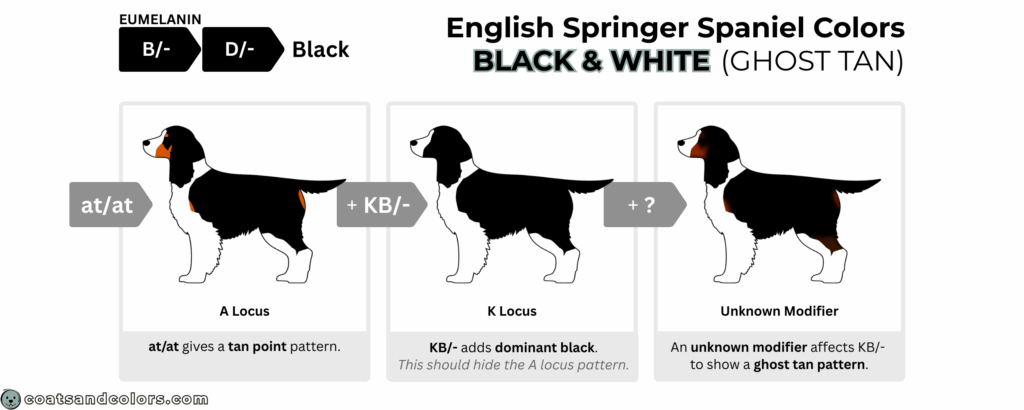
The recessive black allele has also been confirmed, mostly in UK show line Springers[4].
Dogs with ky/ky a/a will also have a solid black coat. This is rare but makes it possible to get a black & white puppy from two tricolor parents if both were recessive black carriers (ky/ky at/a).
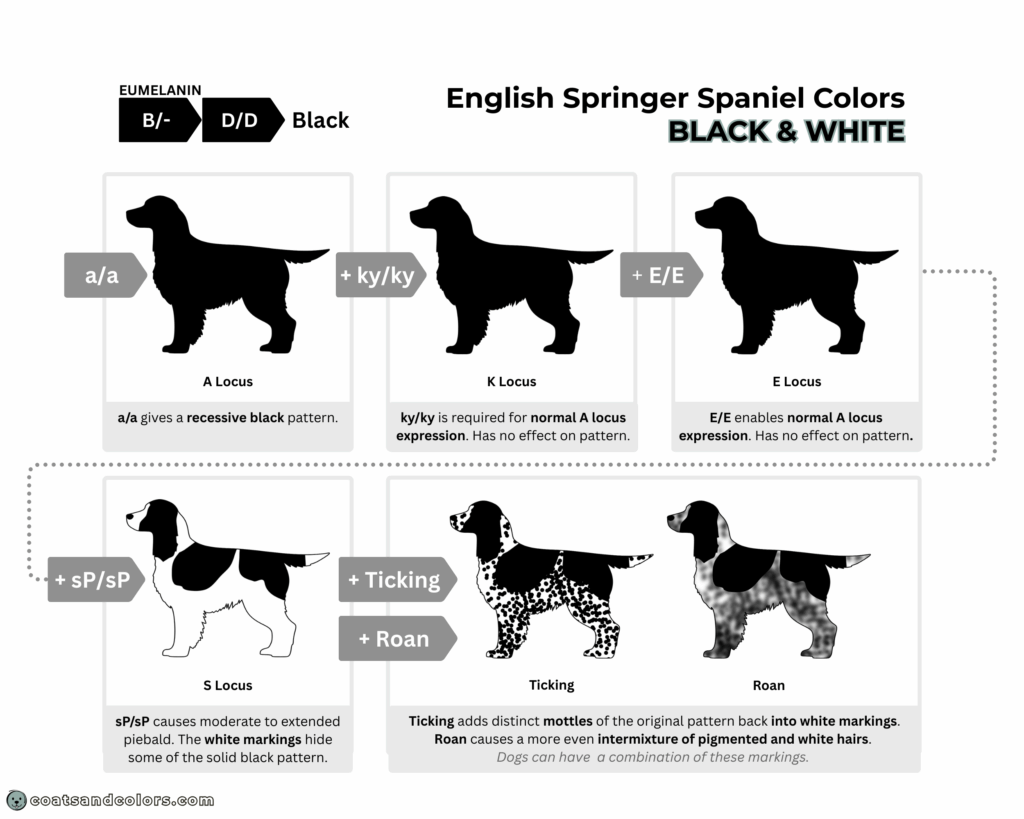
The amount of white on a black ESS can vary from moderate to extended white. There is no exact definition at what point “black & white” turns into “white & black“.
Any white markings can stay solid white, but most Springer Spaniels express some degree of a ticking or roan pattern. Black and white dogs with heavy roaning are called “blue roan“, this is a common breed term in hunting dogs. These dogs still have black eumelanin, they are not really blue (diluted).
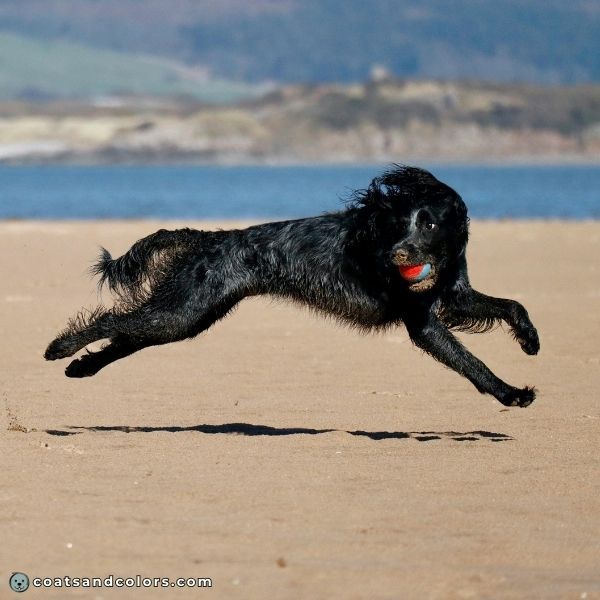
Liver & White English Springer Spaniel

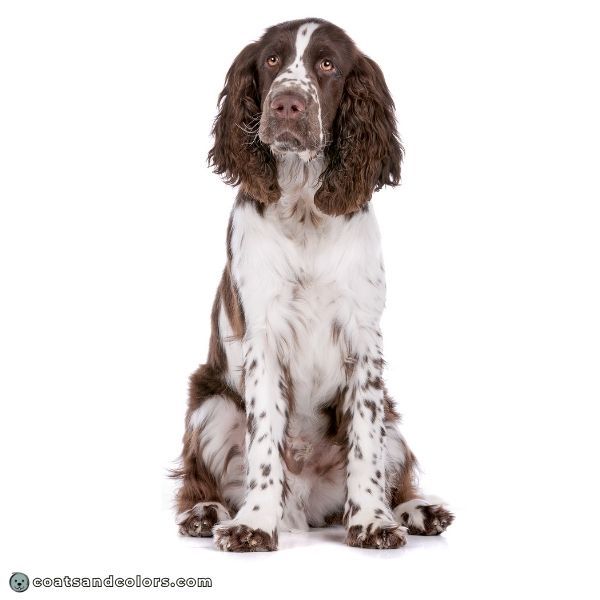
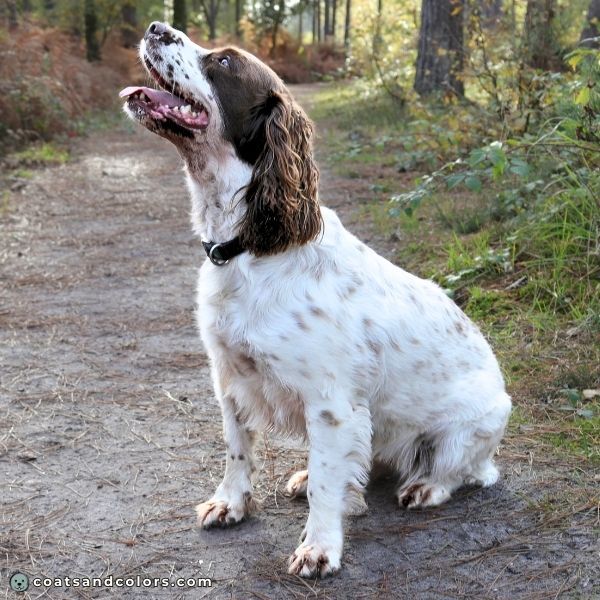
Eumelanin:
brown-based pattern (b/b D/D)
Phaeomelanin:
none
Base Pattern:
dominant black (KB/-)
recessive black (a/a ky/ky)
White:
piebald (sP/sP)
ticking/roan possible
A liver & white English Springers has the same pattern as a black & white. But their eumelanin has been modified from black to liver brown, that’s the only difference.
Most liver ESS are brown-based (b/b) dominant black (KB/-). Their solid brown coat hides the tan point pattern (at/at) at their A locus. They can be E/- (wild type) or Em/- (dark mask) at the E locus. Like with the black dogs, you simply can’t tell if they have a brown mask as they are already solid brown.
A KB/- Springer Spaniel can show ghost tan. But this is rare and often too subtle to notice in liver dogs.
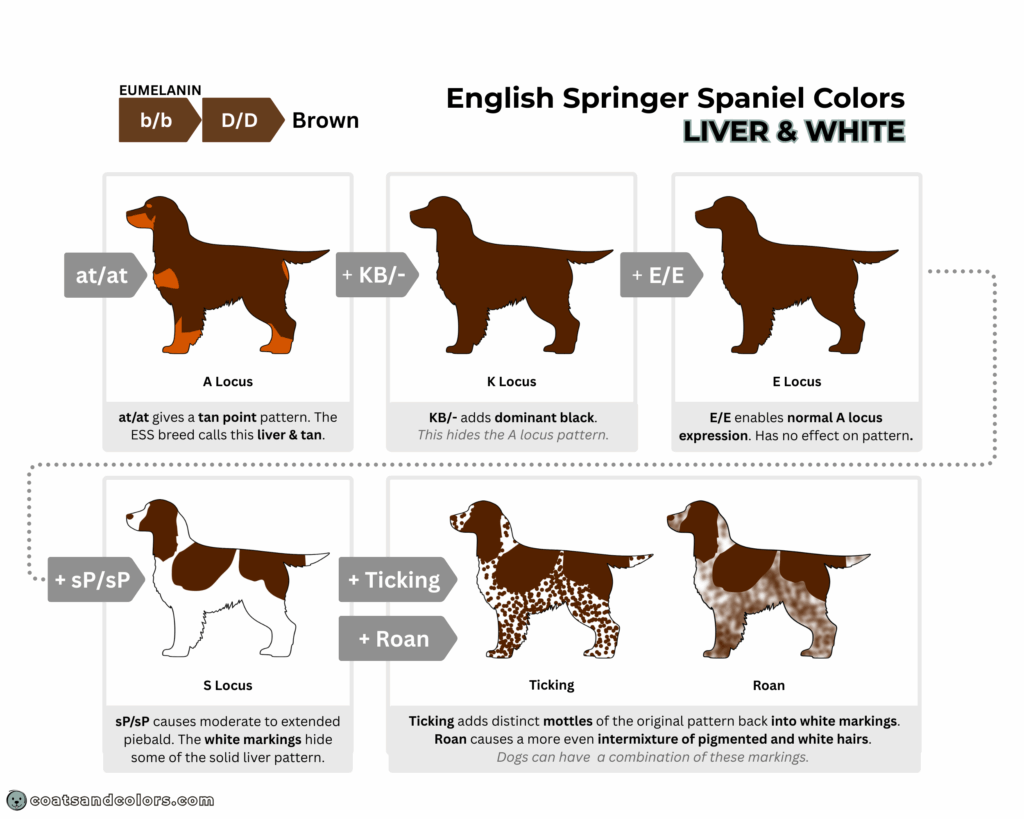
A small number of solid liver & white dogs might be brown-based recessive black (b/b ky/ky a/a).
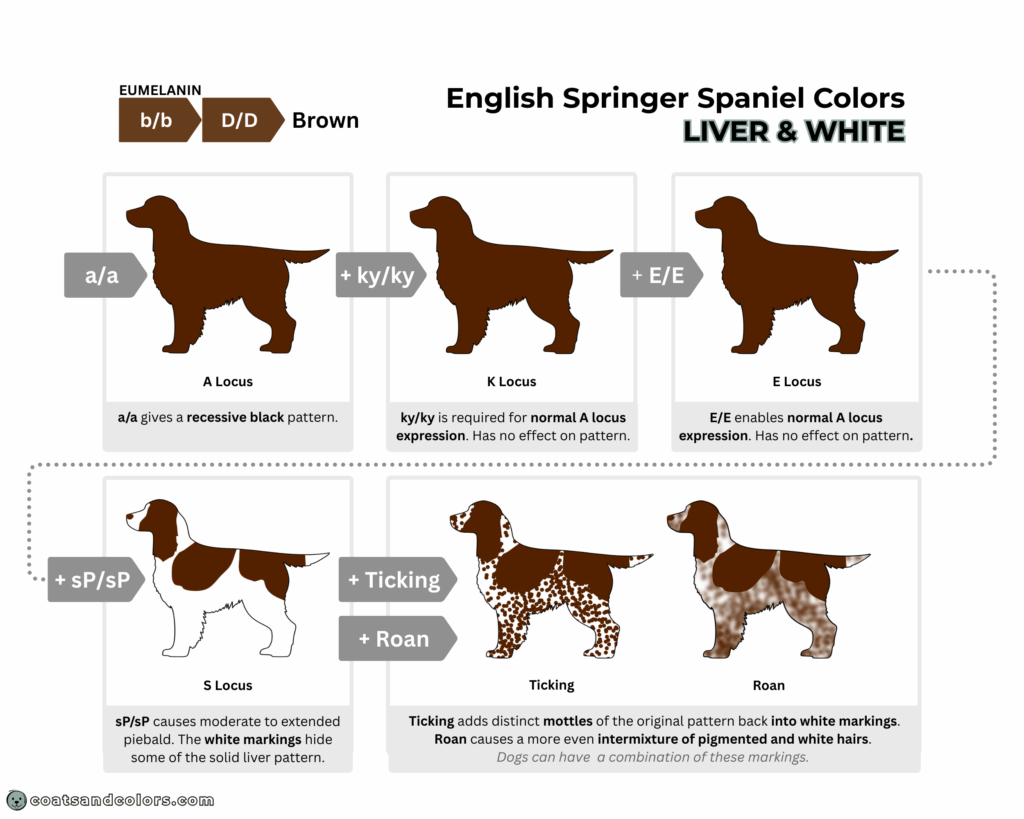
The color of brown pigment is known to vary from dog to dog.
Different shades of liver color can give anything from a light chocolate to a dark brown Springer Spaniel. And old sun-bleached coat on the ears can look more yellow than liver before it grows back.
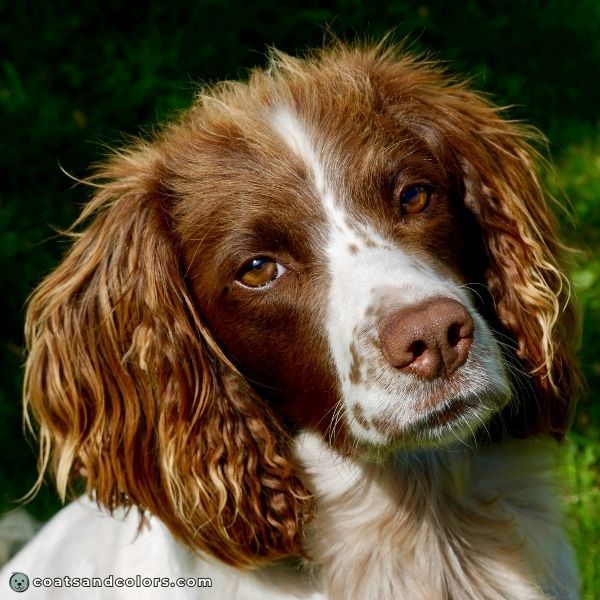
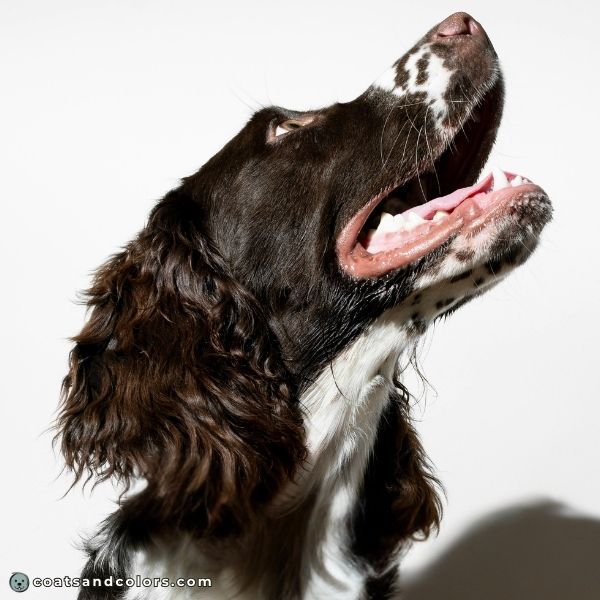
The amount of white on a liver ESS can range from moderate “liver & white” to extended “white & liver”. All liver & white dogs can have minor to heavy ticking or express liver roan.
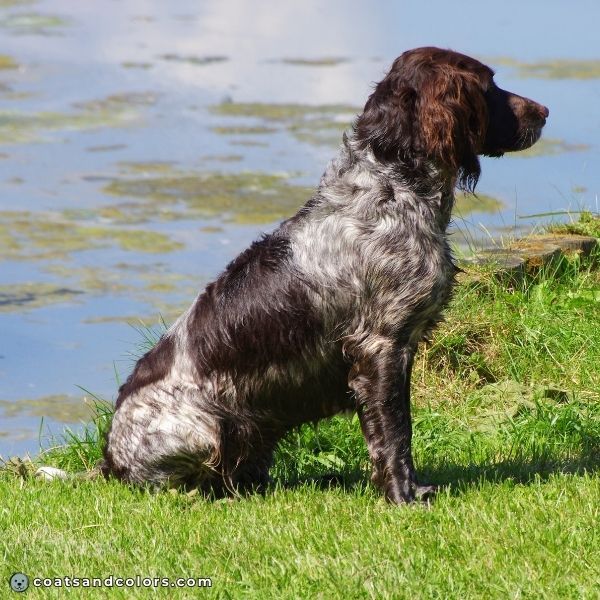
Black White & Tan English Springer Spaniel
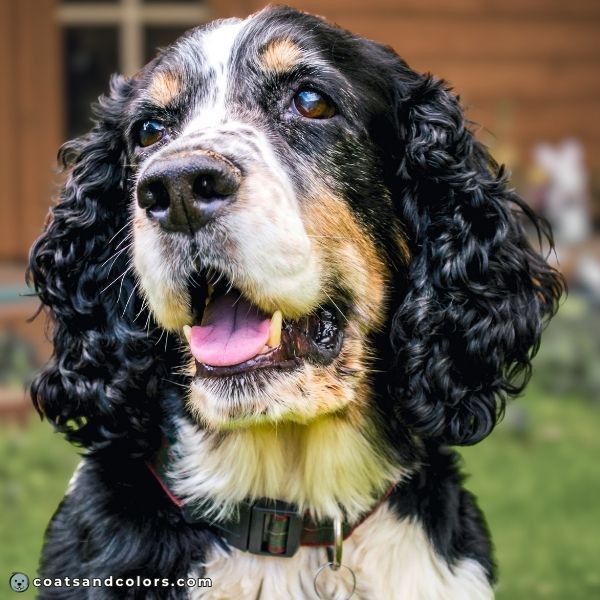
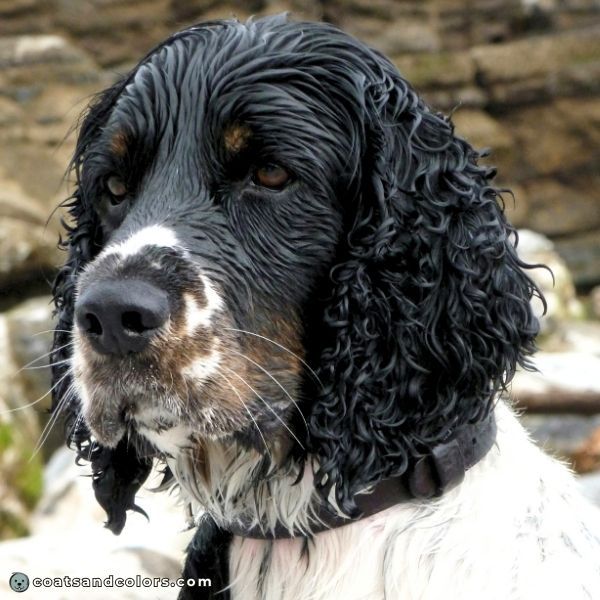
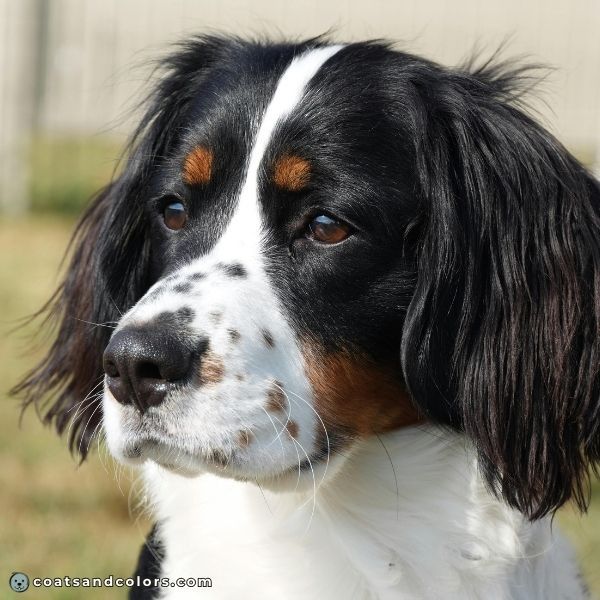
Eumelanin:
black-based pattern (B/- D/D)
Phaeomelanin:
“tan”
Base Pattern:
tan point (at/- ky/ky E/- or Em/-)
White:
piebald (sP/sP)
ticking/roan possible
Most ESS are homozygous tan point at their A locus (at/at). Dogs that can express their pattern (ky/ky) will have tan markings on eyebrows, cheeks, inside of ears, lower legs, and under the tail.
The red intensity of the tan markings can, in theory, vary from red to lemon. The breed standards only mention a “tan” color but typical English Springer Spaniel markings are orange to red.

Tricolor ESS can be E/- (wild type) or Em/- (dark mask) at the E locus. Dogs with Em/- might express a black mask that covers some of the tan markings on their muzzle. But masks often go unnoticed in this breed because most ESS have white markings on their muzzle which hides their face markings.

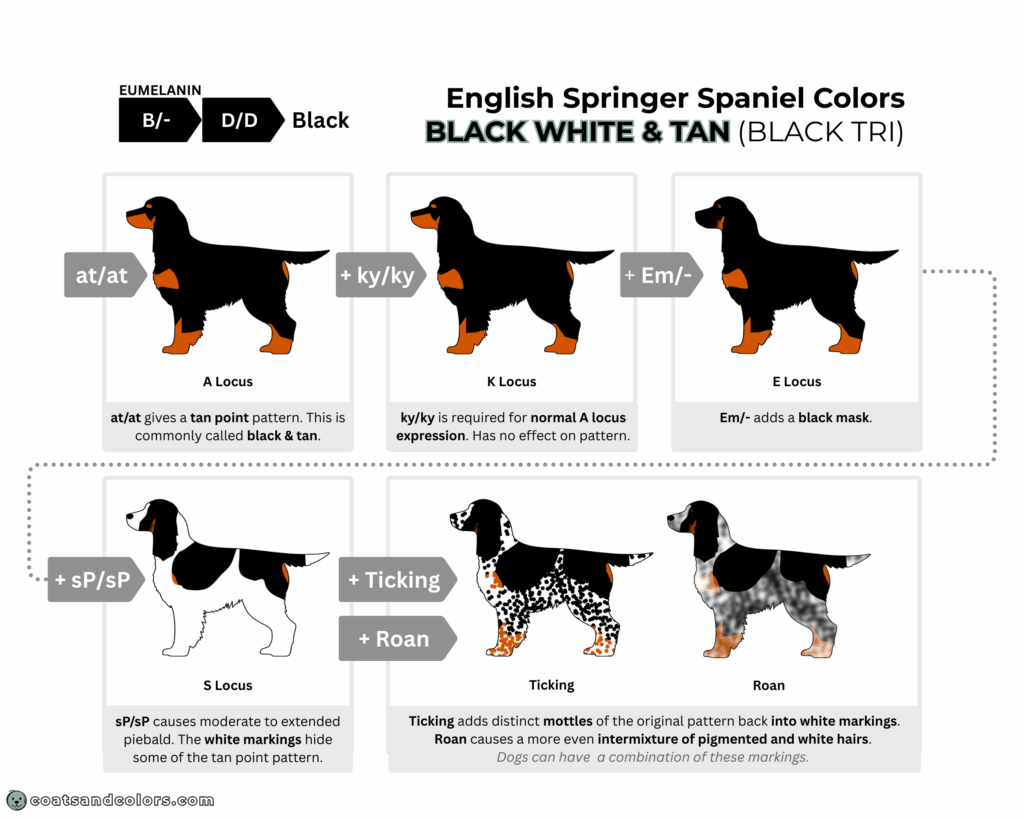
A black & tan dog that carries recessive black (at/a) might express smaller tan points compared to a homozygous tan point (at/at) dog. This is rare but it can happen. It often causes the tan eye pips to get so small and smutty until they disappear entirely.
The amount of white on a black ESS varies from moderate to extended piebald. The common term for a black & tan pattern with some amount of white is black tricolor.
There are ticked and roan tricolor Springer Spaniels, of course.
The color of ticking and roan follows the original base pattern of the coat. Some of the ticking will be tan and some will be black, depending on where in the pattern the mottles are located.

Liver White & Tan English Springer Spaniel
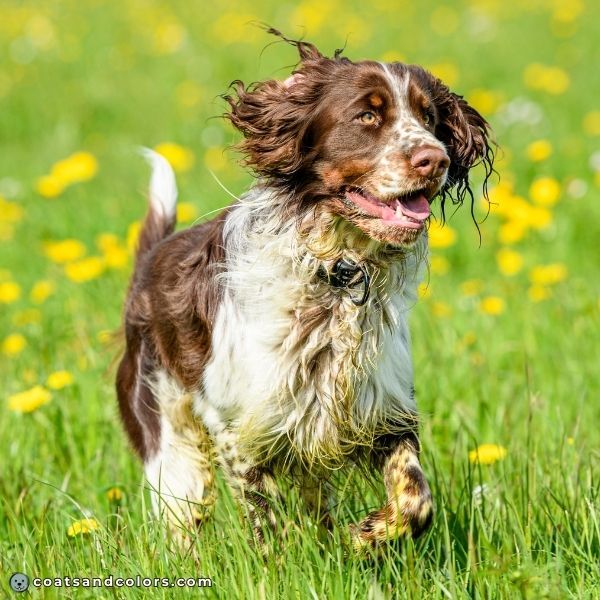
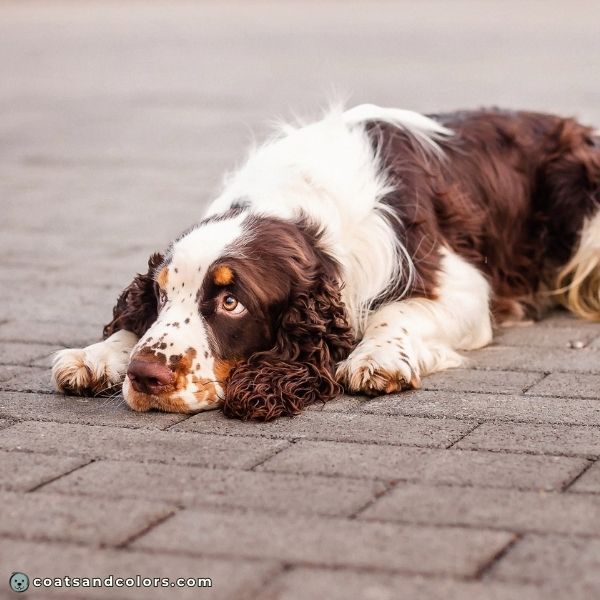

Eumelanin:
brown-based pattern (b/b D/D)
Phaeomelanin:
“tan”
Base Pattern:
tan point (at/- ky/ky E/- or Em/-)
White:
piebald (sP/sP)
ticking/roan possible
A brown-based tan point pattern will cause a predominantly solid liver coat with distinct reddish tan markings on eyebrows, cheeks, inside of ears, lower legs, and under the tail. Springer Spaniel markings range from red to tan colors.
Liver tricolor ESS can have a liver mask (Em/-) which may hide some of the tan markings on their face. Or they can have a wild-type allele (E/-) and will not express a mask.
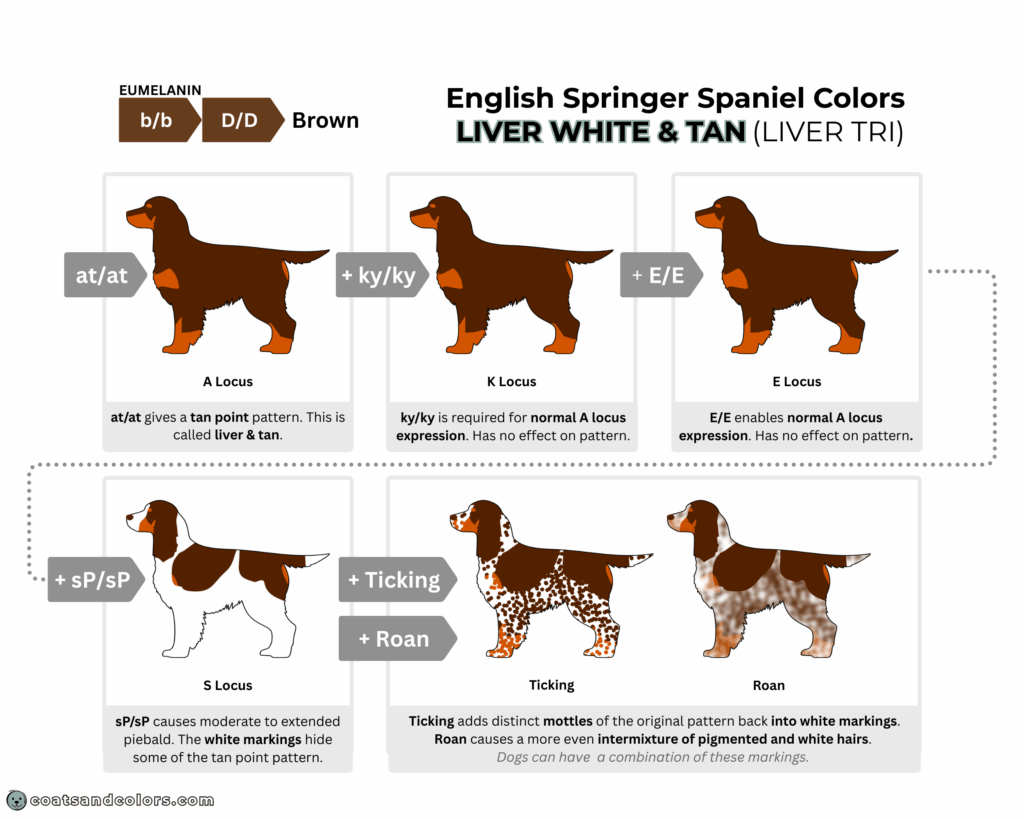

The breed term for a liver & tan pattern with white is liver tricolor. Any ticking or roan inside white markings will show the color of the hidden liver & tan pattern.
English Springer Spaniel White Markings
All Springers express white piebald spotting, almost all of them are homozygous sP/sP at the S locus.
But the wild-type allele S (solid) has also been confirmed, at least in UK field lines[4]. Dogs with S/sP will on average have less white on their body compared to sP/sP.
White is caused by a lack of pigment in some areas of the coat. This will “erase” some of the dog’s original pattern. All patterns (this breed only has solid dark and tan points) can have white markings.
The amount of white in homozygous sP/sP dogs depends on some untestable modifiers and is never fully predictable. Both moderate to slightly extended white are accepted.
Most Springer Spaniels have some white on their legs and body, some white on the muzzle and blaze, a white collar, and a white tail tip. Piebald markings are often asymmetrical.
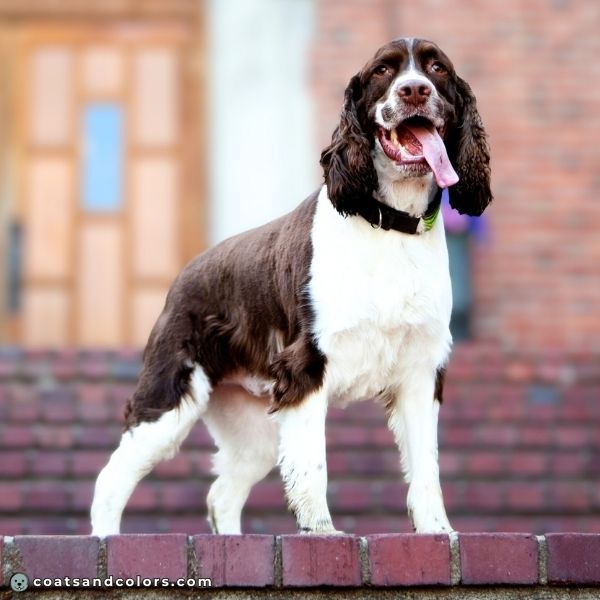

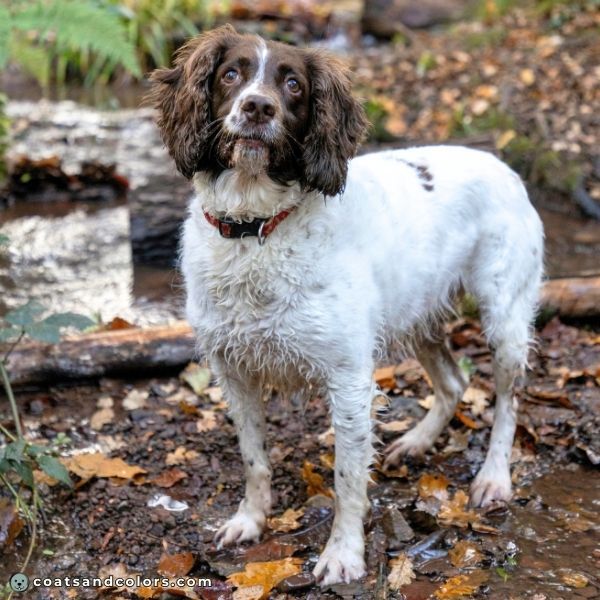
The white on the muzzle will often cause the whiskers to also be white. But you might catch some single whiskers on top of some dark mottles that have kept their black or liver color.
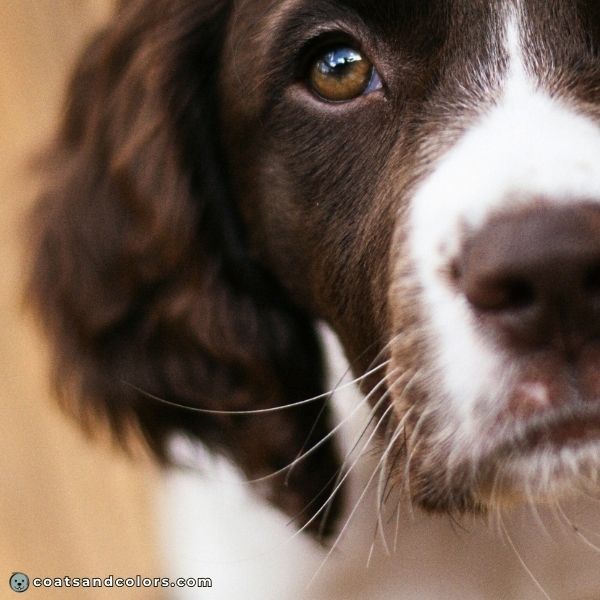
A moderate piebald pattern often gives just some white on the head. But some piebald dogs can also lose head color if the white spotting extends into more extreme piebald versions. Breeders select carefully so the white markings never go beyond the acceptable “contained” version.
The side effects of too much face white such as blue eyes, pink noses, or deafness are not an advantage in the field. Another reason why working breeds like the ESS selected away from too extreme white a long time ago. Even predominantly white English Springer Spaniels dogs typically keep most of the pigment on their head and ears.
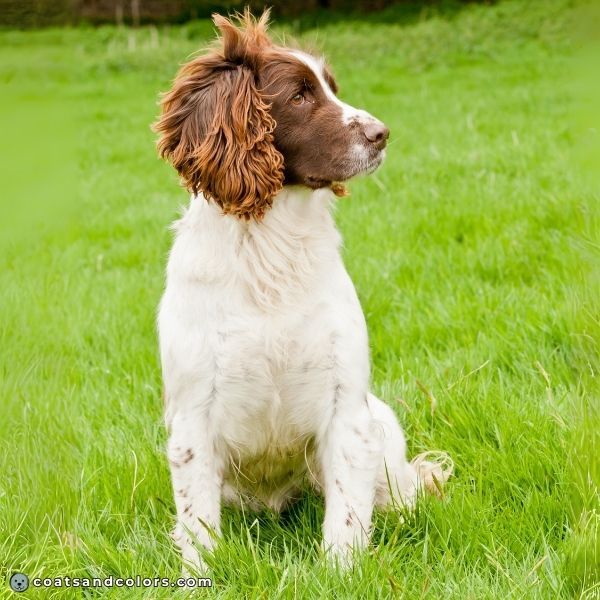
However, some Spaniel breeds also have whitehead (untestable for now). This trait can delete pigment from the face and can cause a split face or clown face even in dogs with only moderate piebald white.
However, in dogs with an overall large amount of white, it is not possible to determine whether face white is due to “piebald gone too far” or if it comes from a sprinkle of whitehead.
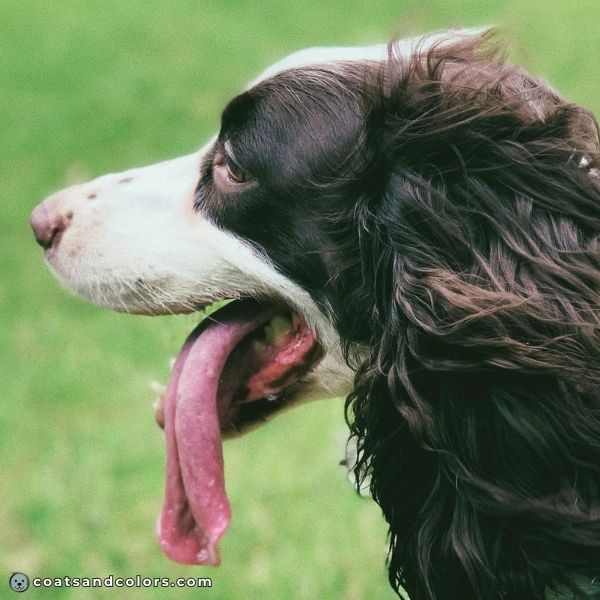
Any dog with too much white on the head has a small risk to also have blue eyes or being born deaf in one or both ears. While traditional hunting breeds with piebald have bred away from extended white face markings for these reasons, dogs with a blue eye or hearing loss can still happen.
English Springer Spaniel Roan & Ticked
Dogs with white on them such as ESS can have ticking or roan.
The AKC website lists ticking and roan as alternate markings.
But the text version of the AKC standard says that “blue roan” or “liver roan” and “white flecked with ticking” are standard colors. A bit contradictory…
Both roan and ticking develop only after birth. All white areas will still be solid white at birth.
Ticking refers to distinct roundish mottles. Dogs can have one or two copies of ticking. Minor ticking often causes only some dense patches of mottles on the muzzle and lower legs.
Heavy ticking can cover all of the white on a dog with mottles. The AKC tries to distinguish between dogs with large, round, individual spots (“spotted”) and dogs with lots of smaller mottles (“ticked“).
Dogs with roan don’t have these well-defined dots but rather a dense mixture of dark hairs and white hairs. Heavy roaning can re-introdcue a lot of pigment into white areas.
And some dogs express roan but still have mottles at the same time.
This is because ticking and roan are different traits.
It is not fully understood if roan and ticked are fully separate traits or if roan is just an allele of the ticking family (TR > T > t). Ticking (T) shows incomplete dominance over clear white (t). Dogs with one copy (T/t, TR/t) show less of this pattern than dogs with two copies (TR/TR, TR/T, T/T).
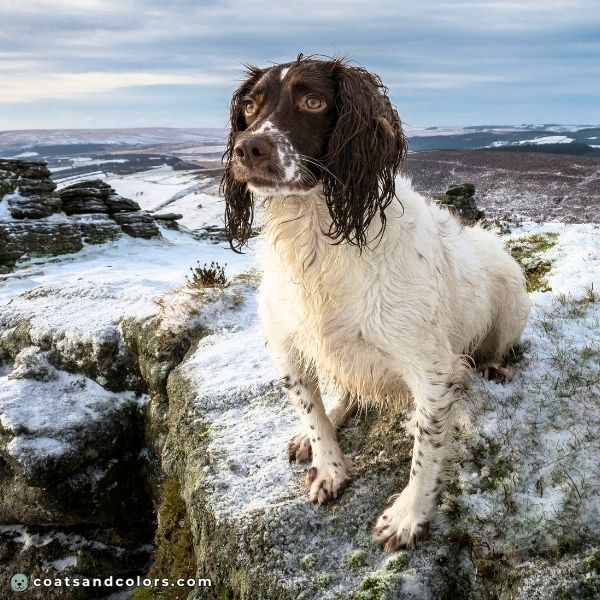
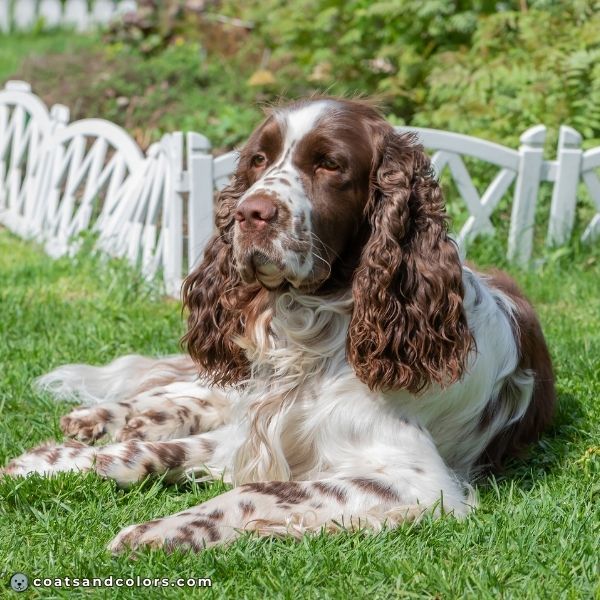
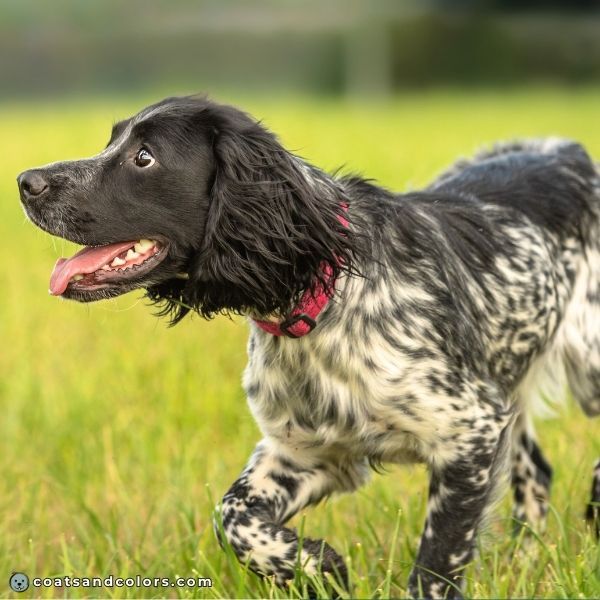
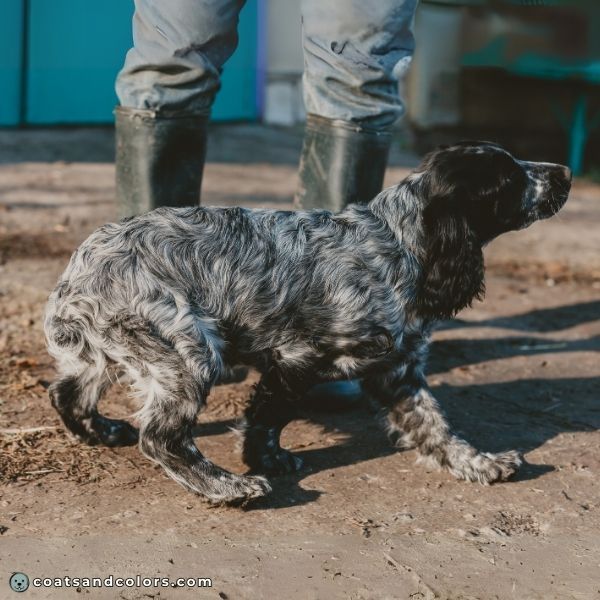
English Springer Spaniel Eye Colors
“The color of the iris harmonizes with the color of the coat, preferably dark hazel in the liver and white dogs and black or deep brown in the black and white dogs. Eye rims are fully pigmented and match the coat in color.
[…] eyes that are yellow or brassy in color, are highly undesirable.”
AKC Breed Standard[1]
“Dark hazel. Light eyes undesirable.”
FCI Breed Standard[2]
Eye color depends on the color, amount and distribution of melanin in the iris.
ESS have either black or brown eumelanin.
The breed standards favor dogs with darker eye colors. So breeders tend to select away from yellow eye colors which can be harder in liver dogs since these naturally come with lighter eyes.
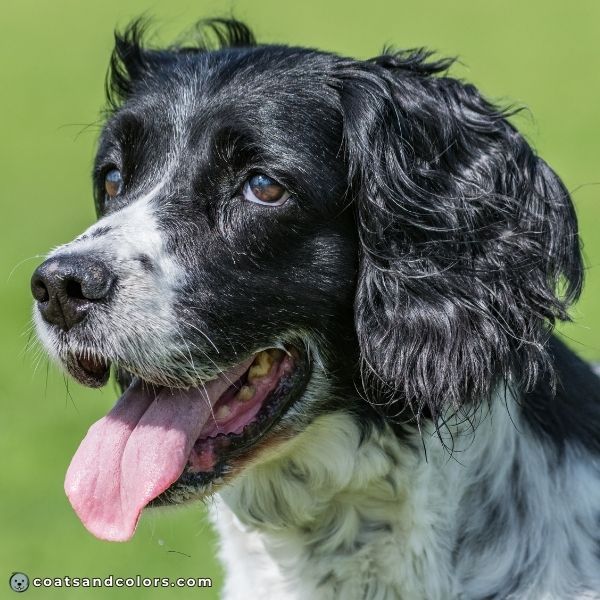


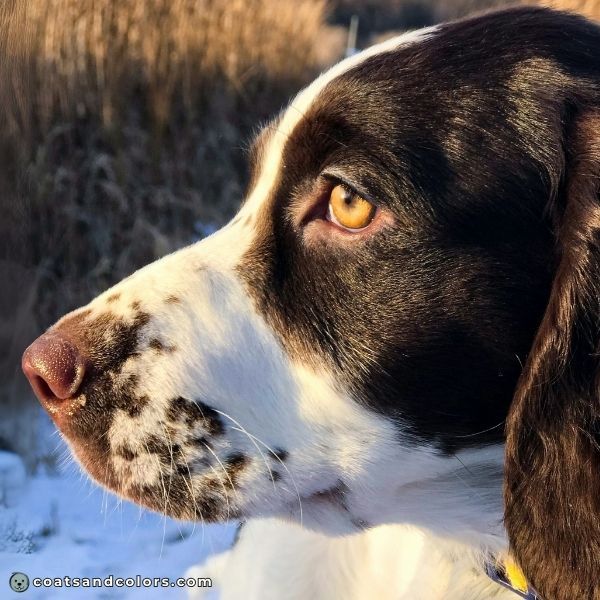
Some young puppies might still have very pale greenish or bluish eyes. This is very normal for young dogs and their eye color will darken over time as more pigment fills in.
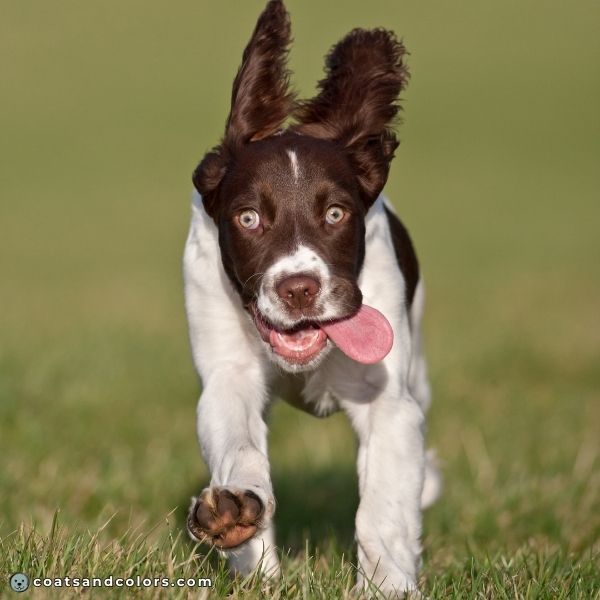
English Springer Spaniel Nose Colors
“The nose is fully-pigmented, liver or black in color, depending on the color of the coat.”
AKC Breed Standard[1]
Springer Spaniels either have a black or a brown nose. Their color of eumelanin will also affect the color of their eye rims, lips, paw pads, nails, or whiskers, etc.
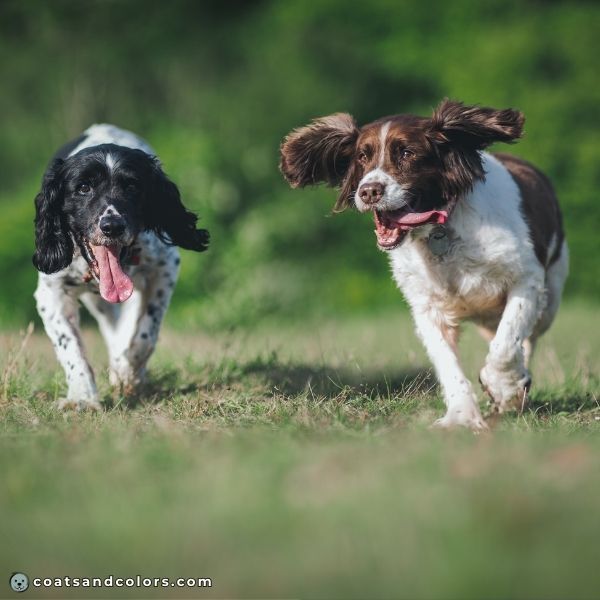
English Springer Spaniel Non-Standard Colors
Almost all standards list coat colors that are not desirable.
Some out-of-standard coat colors can even disqualify a dog from breeding.
English Springer Spaniel colors don’t have that much variety.
The only accepted patterns are solid with white or tan point with white (tricolor) with or without ticking or roan. Their eumelanin can be black or brown. All other patterns are considered faulty.
“Off colors such as lemon, red or orange are not to place.”
AKC Breed Standard[1]
But there is a difference between simple mismarks and what I call fancy colors.
- A mismark includes any “faulty” coat color that can happen in the purebred population. These “rare colors” are uncommon because they are often produced by recessive alleles. This is not a bad thing, it can occasionally happen to any breeder and does not necessarily indicate cross-breeding.
- A fancy color, on the other hand, is caused by a coat color trait that was introduced on purpose due to gene flow from another breed. One of the most common examples includes Merle in traditionally non-Merle breeds. Always be wary of breeders who advertise “rare colors” or sell them at a higher price.
These are some non-standard colors of the English Springer Spaniel:
Sable English Springer Spaniel
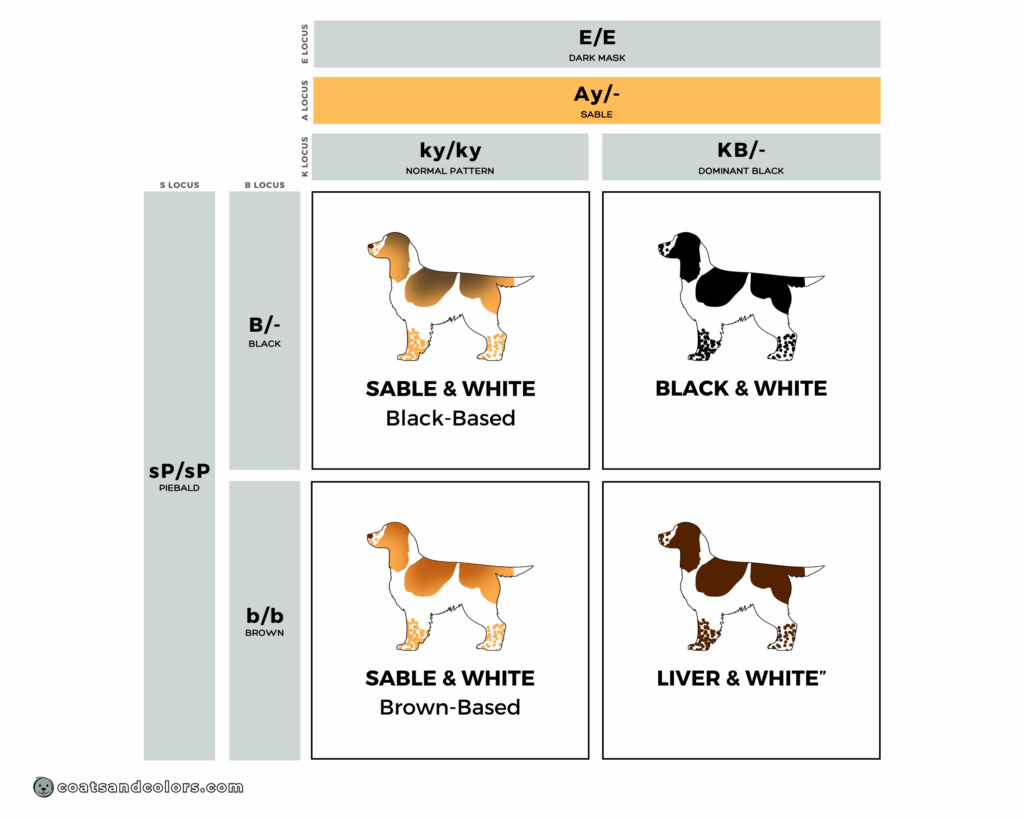
The only accepted pattern with tan expression in ESS is tan point, they should be fixed for at/at. However, the sable allele (Ay) has been confirmed in this breed[4].
This will go unnoticed in KB/- Ay/- dogs because the A locus pattern is hidden in dogs with a solid dark coat. But when accidentally producing a ky/ky Ay/-, the puppy will express a sable pattern.

Sable can be black-based (B/-) or brown-based (b/b).
Sable dogs can express some dark puppy shading but will often clear to solid yellow in adulthood. They can have dark whiskers (unless white spotting on their muzzle also affected their whiskers).
Depending on red intensity, a solid tan Springer Spaniel will be called lemon, orange, or red. But dogs with visible sable shading are often called “red sable” or just “sable” or “fawn“.
Red, Orange, Lemon English Springer Spaniel
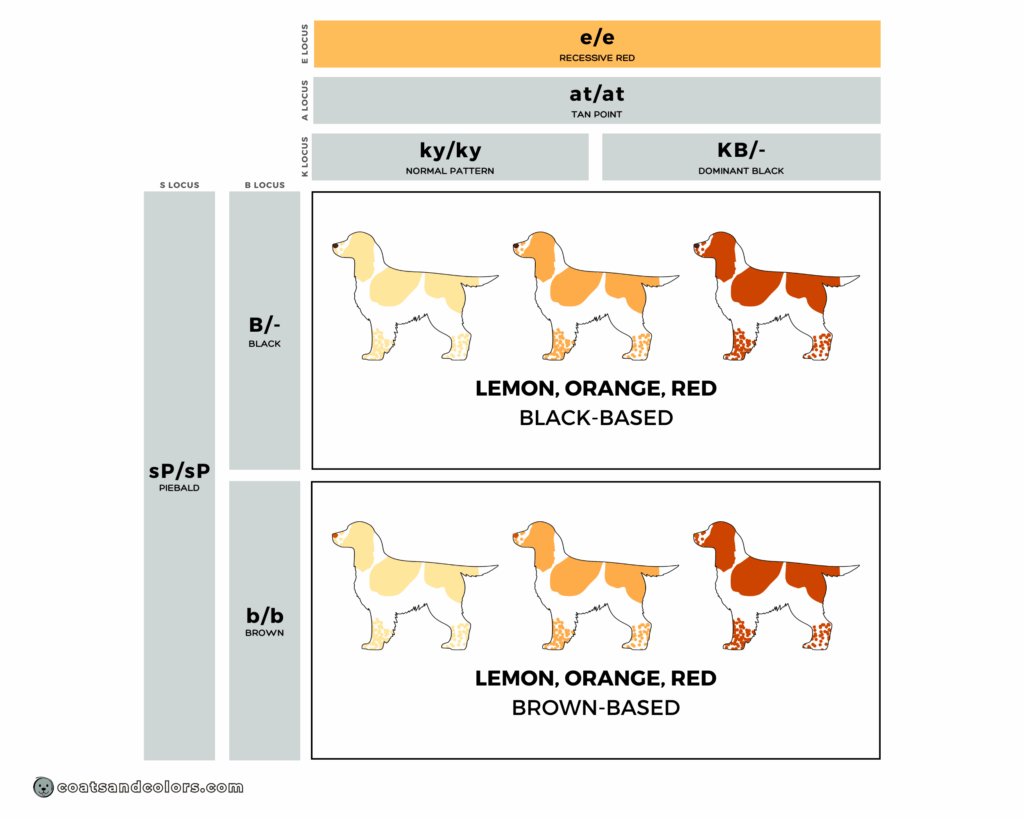
Most ESS are homozygous E/E (wild type) at the E locus.
A small number of Springer Spaniels might be recessive red carriers (E/e).
Since e is a recessive allele, it is possible that it was present in the breed from the beginning. Or it could have been accidentally introduced through more recent crossbreeding with related breeds such as Cocker Spaniels or Welsh Springers. Or maybe a bit of both.
Breeding from two carriers can result in some puppies being born with a homozygous e/e genotype.

Being e/e causes recessive red and will hide what a dog has at its A locus and K locus. A recessive red ESS can only ever express tan pigment (phaeomelanin) in its coat from birth. It has pale whiskers and often develops a flesh-colored nose.
The recessive red pattern can be black-based or brown-based. An e/e dog can’t have black or brown in their coat, but you will still see their pigment color when you look at their nose or eye rims.
Depending on the intensity of their phaeomelanin, these dogs are classified as red, orange, or lemon. Dogs with recessive red can also express lemon or red ticking or roan in their white markings.
I don’t have access to images of lemon ESS, but it looks something like this:
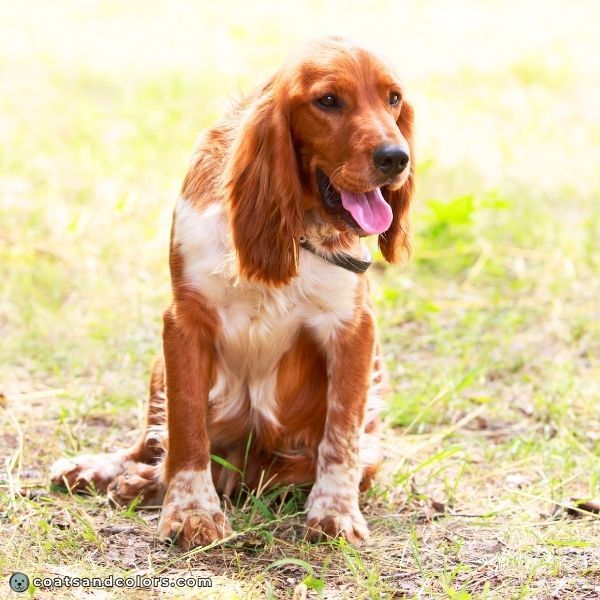
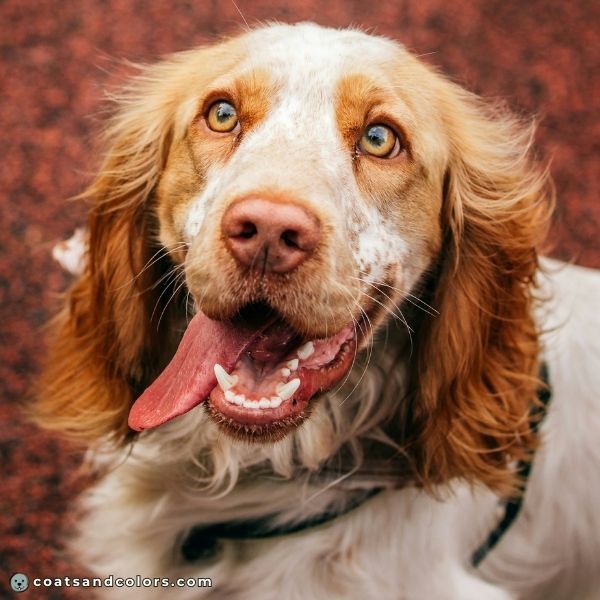
Learn More
Links
[1] American Kennel Club (AKC): English Springer Spaniel
[2] Fédération Cynologique Internationale (FCI): English Springer Spaniel
[3] Kennel Club (KC): English Springer Spaniel
[4] Dreger et al. (2019). True Colors: Commercially-acquired morphological genotypes reveal hidden allele variation among dog breeds, informing both trait ancestry and breed potential. PLoS ONE 14(10): e0223995. https://doi.org/10.1371/journal.pone.0223995
Image Credits
© beinder/canva.com
© Meaghan Cafferty/unsplash.com
© Jared Lightning/pexels.com
© eriklam/yayimages.com
© Tory/pexels.com
© Rafaëlla Waasdorp/unsplash.com
© bastien caublot/unsplash.com
© Erin Vey/unsplash.com
© John Debrey/unsplash.com
© Tim Riesner/unsplash.com
© Romy Du Toit/unsplash.com
© Fi Dogs/unsplash.com
© Adam King/unsplash.com
© Eva :)/unsplash.com
© Dom Heartley/unsplash.com
© Alyssa li/unsplash.com
© Jana Briede/unsplash.com
© Raoul Croes/unsplash.com
© Samuel Meller/unsplash.com
© Dan/unsplash.com
© Angela/pixabay.com
© Matthew Smith/canva.com
© steved_np3/canva.com
© BrankoPhoto/canva.com
© Stockjohnw/canva.com
© Robjem/canva.com
© Darren Wordley/canva.com
© Mariya Tochilkina/canva.com
© SW_Photo/canva.com
© Kemter/canva.com
© Lusyaya/canva.com
© K_Thalhofer/canva.com
© glebchik/canva.com
© DevidDoO/canva.com
© FoYu/pixabay.com
© appletat/canva.com

Hi! I’m Steffi. I am a biologist and a big time dog nerd. You are curious about coat color genetics? You’ve come to the right place! Read more.

